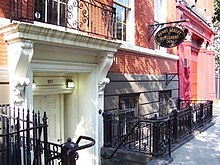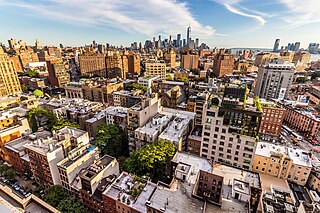
Greenwich Village, or simply the Village, is a neighborhood on the west side of Lower Manhattan in New York City, bounded by 14th Street to the north, Broadway to the east, Houston Street to the south, and the Hudson River to the west. Greenwich Village also contains several subsections, including the West Village west of Seventh Avenue and the Meatpacking District in the northwest corner of Greenwich Village.

Harlem is a neighborhood in Upper Manhattan, New York City. It is bounded roughly by the Hudson River on the west; the Harlem River and 155th Street on the north; Fifth Avenue on the east; and Central Park North on the south. The greater Harlem area encompasses several other neighborhoods and extends west and north to 155th Street, east to the East River, and south to Martin Luther King Jr. Boulevard, Central Park, and East 96th Street.
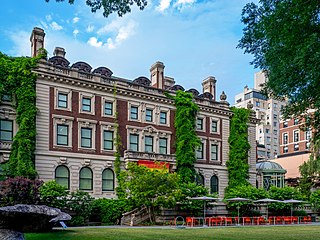
Carnegie Hill is a neighborhood within the Upper East Side, in the borough of Manhattan in New York City. Its boundaries are 86th Street on the south, Fifth Avenue on the west, with a northern boundary at 98th Street that continues just past Park Avenue and turns south to 96th Street and proceeds east up to, but not including, Third Avenue. The neighborhood is part of Manhattan Community District 8.

Avenue D is the easternmost named avenue in the East Village neighborhood of Manhattan, New York City, east of Avenue C and west of the FDR Drive. It runs through East 13th and Houston Streets, and continues south of Houston Street as Columbia Street until Delancey Street and Abraham E. Kazan Street until its end at Grand Street. Avenues A, B, C and D are the origin of the name of the section of the East Village neighborhood through which they run, Alphabet City.

Lillian D. Wald was an American nurse, humanitarian and author. She strove for human rights and started American community nursing. She founded the Henry Street Settlement in New York City and was an early advocate for nurses in public schools.
Home health is a nursing specialty in which nurses provide multidimensional home care to patients of all ages. Home health care is a cost efficient way to deliver quality care in the convenience of the client's home. Home health nurses create care plans to achieve goals based on the client's diagnosis. These plans can include preventive, therapeutic, and rehabilitative actions. Home health nurses also supervise certified nursing assistants. The professional nursing organization for home health nurses is the Home Healthcare Nurses Association (HHNA). Home health care is intended for clients that are well enough to be discharged home, but still require skilled nursing personnel to assess, initiate and oversee nursing interventions.

Henry Street is a street in the Lower East Side of the New York City borough of Manhattan that runs one-way eastbound, except for two small two-way segments west of Pike Street and east of Montgomery Street. It spans from Oliver Street in the west, passing underneath the Manhattan Bridge and on to Grand Street in the east ("north"). The street is named for Henry Rutgers, a hero of the American Revolutionary War, and prominent philanthropist. Rutgers Street, which intersects with Henry Street, is also named for him.

203 Prince Street is an historic townhouse on Prince Street between MacDougal and Sullivan Streets in the SoHo neighborhood of Lower Manhattan, New York City, United States. Built in 1834 with 2+1⁄2 stories on land that was once part of the estate of Aaron Burr, the house acquired an additional full story in 1888. Primarily constructed in the late Federal style, the building also has elements of the Greek Revival style.
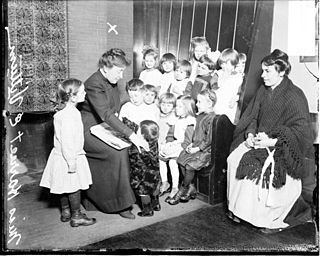
The Northwestern University Settlement House is an Arts and Crafts style house located at 1400 West Augusta Boulevard in Chicago, Illinois, United States. The Settlement Association was founded in 1891 by Northwestern University to provide resources to the poor and new immigrants to the West Town neighborhood. The actual Settlement House structure was built in 1901 by Pond & Pond. It was designated a Chicago Landmark on December 1, 1993.
Hamilton-Madison House is a voluntary, non-profit settlement house dedicated to improving the quality of life of its community, primarily that of the Two Bridges/Chinatown area of the Lower East Side of Manhattan, New York City, United States. The neighborhood is a federally designated poverty area, with a constantly changing mixture of ethnic groups, and lack of adequate services and resources. An average income of a family living in the area is $17,000. Further, more than 25% of the seniors live on less than $15,000 a year, of which 40% goes toward housing. In the past 108 years, Hamilton-Madison House has developed programs that meet the changing needs of its community. In 1965, with a change in federal immigration policies, the community's predominant immigrant became Chinese New Yorkers. Since that time, the organization's staff has grown to include a staff of 300 who collectively speak 15 languages, including 6 Chinese dialects. Further, the House's long-standing programs have been adapted to meet the cultural norms of this expanding population.

Lavinia Lloyd Dock was an American nurse, feminist, writer, pioneer in nursing education and social activist. Dock was an assistant superintendent at Johns Hopkins School of Nursing under Isabel Hampton Robb. She founded what would become the National League for Nursing with Robb and Mary Adelaide Nutting. Dock was a contributing editor to the American Journal of Nursing and authored several books, including a four-volume history of nursing and Materia Medica for Nurses, the nurse's standard manual of drugs for many years. In her later life, she also campaigned for social reform, particularly women's rights.
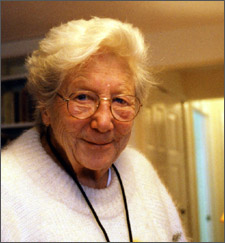
Florence Wald was an American nurse, former Dean of Yale School of Nursing, and largely credited as "the mother of the American hospice movement". She led the founding of Connecticut Hospice, the first hospice program in the United States. Late in life, Wald became interested in the provision of hospice care within prisons. In 1998, Wald was inducted into the National Women's Hall of Fame.
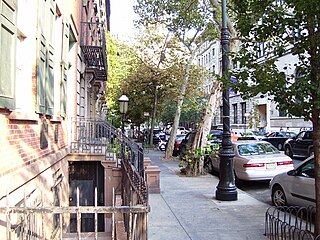
St. Mark's Historic District is a historic district located in the East Village neighborhood of Manhattan, New York City. The district was designated a city landmark by the New York City Landmarks Preservation Commission in 1969, and it was extended in 1984 to include two more buildings on East 10th Street. It was listed on the National Register of Historic Places in 1974 and was expanded in 1985. The boundaries of the NRHP district and its expansion are now coterminous with those of the LPC.

Hudson Square is a neighborhood in Lower Manhattan in New York City. It is bounded approximately by Clarkson Street to the north, Canal Street to the south, Varick Street to the east, and the Hudson River to the west. To the north of the neighborhood is Greenwich Village, to the south is TriBeCa, and to the east are the South Village and SoHo. The area, once the site of the colonial property named Richmond Hill, became known in the 20th century as the Printing District, and into the 21st century it remains a center of media-related activity, including in advertising, design, communications, and the arts.
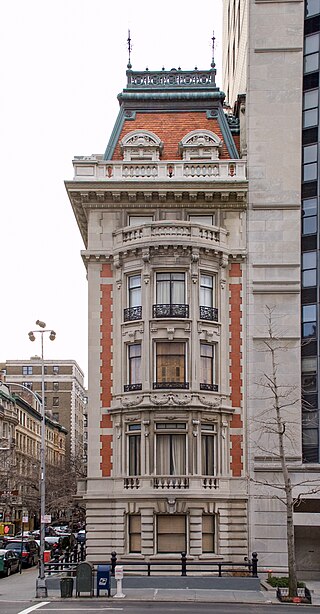
The Benjamin N. Duke House, also the Duke–Semans Mansion and the Benjamin N. and Sarah Duke House, is a mansion at 1009 Fifth Avenue, at the southeast corner with 82nd Street, on the Upper East Side of Manhattan in New York City. It was built between 1899 and 1901 and was designed by the firm of Welch, Smith & Provot. The house, along with three other mansions on the same block, was built speculatively by developers William W. Hall and Thomas M. Hall. The Benjamin N. Duke House is one of a few remaining private mansions along Fifth Avenue. It is a New York City designated landmark and is listed on the National Register of Historic Places.

Founded in 1893 by nursing pioneer Lillian D. Wald and Mary M. Brewster, VNS Health is one of the largest not-for-profit home- and community-based health care organizations in the United States, serving the five boroughs of New York City; Nassau, Suffolk, and Westchester Counties; and parts of upstate New York.

The New Federal Theatre is a theatre company named after the African-American branch of the Federal Theatre Project, which was created in the United States during the Great Depression to provide resources for theatre and other artistic programs. The company has operated out of a few different locations on Henry Street in the Lower East Side of Manhattan. Since 1970 The New Federal Theatre has provided its community with a stage and collection of talented performers to express the voices of numerous African-America playwrights. New Federal Theatre boasts nationally known playwrights such as Ron Milner (Checkmates), Ed Bullins, and Ntozake Shange as well as actors including Jackée Harry, Morgan Freeman, Denzel Washington, Debbie Allen, Phylicia Rashad, Dick Anthony Williams, Glynn Turman, Taurean Blacque, Samuel L. Jackson, and Laurence Fishburne.

Vandam Street is a street in the Hudson Square neighborhood of Lower Manhattan in New York City. It runs east to west from Sixth Avenue to Greenwich Street.
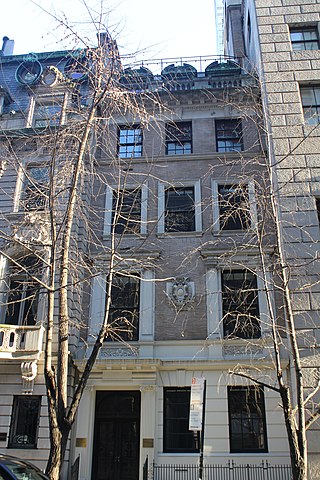
5 West 54th Street is a commercial building in the Midtown Manhattan neighborhood of New York City. It is along 54th Street's northern sidewalk between Fifth Avenue and Sixth Avenue. The four-story building was designed by R. H. Robertson in the Italian Renaissance Revival style and was constructed between 1897 and 1899 as a private residence. It is the easternmost of five consecutive townhouses erected along the same city block during the 1890s, the others being 7, 11, 13 and 15 West 54th Street. The first floor is clad with rusticated blocks of limestone, while the other floors contain buff-colored brick trimmed with limestone.
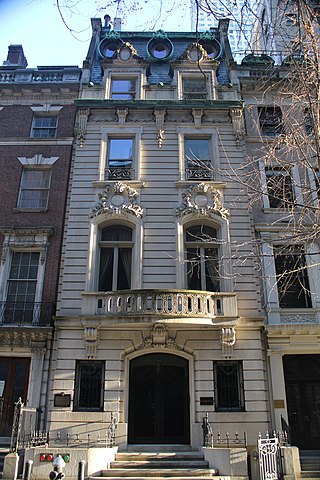
7 West 54th Street is a commercial building in the Midtown Manhattan neighborhood of New York City. It is along 54th Street's northern sidewalk between Fifth Avenue and Sixth Avenue. The four-story building was designed by John H. Duncan in the French Beaux-Arts style and was constructed between 1899 and 1900 as a private residence. It is one of five consecutive townhouses erected along the same city block during the 1890s, the others being 5, 11, and 13 and 15 West 54th Street.


